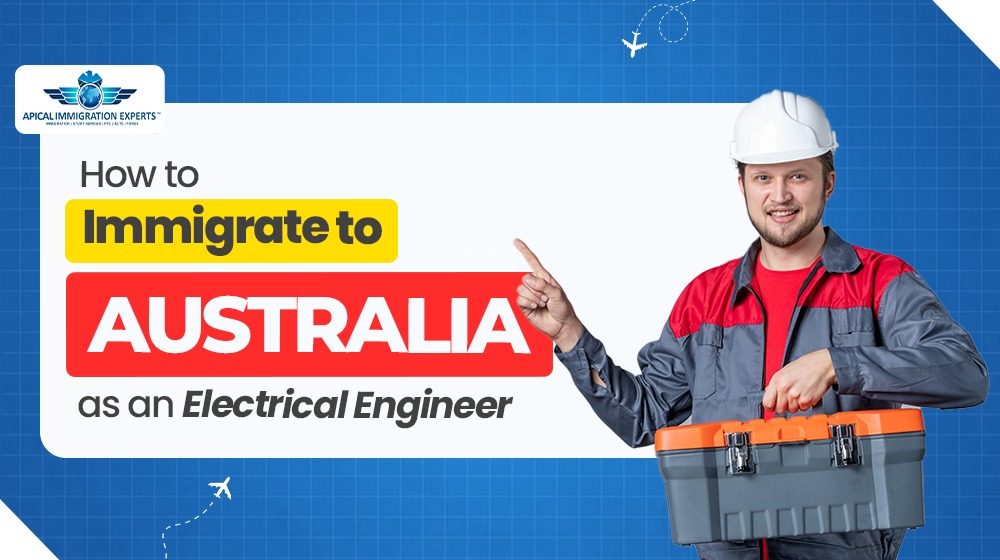Ever wondered how electricity reaches homes, offices, and industries every moment without interruption? Behind this seamless supply are electrical engineers—the professionals who design, build, and maintain the systems that keep entire cities powered.
If you’re an electrical engineer planning to move to Australia and aim for permanent residency, this guide explains, step-by-step, how to make that goal possible.
Who Is an Electrical Engineer? (ANZSCO Code 233311)
An Electrical Engineer (ANZSCO Code – 233311) is a technical expert who plans, develops, and oversees the manufacturing, installation, functioning, and upkeep of electrical machinery, devices, and systems used for electricity generation. They also handle the distribution, application, and regulation of electrical power.
In recent years, the demand for electrical engineers in Australia has increased significantly, making it one of the top high-paying careers in the country. Owing to the widening demand–supply gap, electrical engineers have also been listed on the Australia Shortage Occupation List.
Shortage Status Across Australia
| State / Territory | Status |
| National (Australia) | Shortage |
| Australian Capital Territory | Shortage |
| New South Wales | Shortage |
| Northern Territory | Shortage |
| Queensland | Shortage |
| South Australia | Shortage |
| Tasmania | Shortage |
| Victoria | Shortage |
| Western Australia | Shortage |
Key Responsibilities of an Electrical Engineer
Electrical engineers perform a wide range of activities that support essential infrastructure. Some major duties include:
- Designing and planning electrical plants and power-related systems
- Creating layouts for circuits, transformers, and power lines
- Developing products such as motors, machinery, and electrical equipment
- Reviewing engineering standards, blueprints, and electrical regulations
- Coordinating production and installation of electrical components
- Scheduling system installation and equipment delivery
- Monitoring functioning and maintenance of power stations and industrial plants
- Designing traffic control systems for road, rail, and aviation
- Conducting research in power generation, motor design, and electrical control systems
Visa Pathways for Electrical Engineers in Australia
-
Skilled Independent Visa (Subclass 189)
The Subclass 189 visa is a points-based independent immigration pathway that does not require sponsorship or nomination. Eligible applicants can migrate solely based on their skills and experience.
-
Skilled Nominated Visa (Subclass 190)
Subclass 190 is a state-nominated visa that enables applicants to migrate when selected by Australian states such as NSW, Queensland, or South Australia.
-
Skilled Work Regional Visa (Subclass 491)
Subclass 491 allows skilled professionals to migrate to regional areas like Hobart, Perth, and Gold Coast through state or regional nominations.
-
Temporary Graduate Visa (Subclass 485)
A pathway for international students who completed an Australian qualification and wish to gain local experience.
Average Salary for Electrical Engineers in Australia
Electrical engineering is one of Australia’s high-paying technical fields. Salaries vary depending on experience and skill level.
| Role | Average Weekly Salary | Average Annual Salary |
| Electrical Engineer | $2,365 | $122,990 |
How to Immigrate to Australia as an Electrical Engineer: Step-by-Step Process
Step 1: Check Your Eligibility
The first stage is reviewing eligibility based on the points system (minimum 65 points) and verifying whether the occupation appears on the Skilled Occupation List. Points are awarded for:
- Age
- Skilled employment
- Education level
- English proficiency (IELTS, PTE, TOEFL)
Your occupation must also appear on the Skilled Occupation List.
Step 2: Get a Skill Assessment (Engineers Australia)
Electrical engineers must obtain a positive skills assessment from Engineers Australia. Required documents usually include:
- Passport
- Reference letters
- Work experience proofs
- Bank statements (3–6 months)
- English test scorecard
Step 3: Submit an ROI (For Subclass 190 & 491)
A Registration of Interest shows you are willing to be considered for nomination by an Australian state or territory.
Step 4: Lodge an EOI Through Skill Select
An Expression of Interest allows authorities to assess your migration purpose and your suitability for available visa options.
Step 5: Receive an Invitation to Apply (ITA)
Once you receive an ITA, you can proceed with the final visa application and submit supporting documents.
Why Electrical Engineers Are Choosing Australia
Australia’s increasing investments in renewable energy, infrastructure development, and emerging technologies have created exceptional opportunities for skilled engineers. Hence, migration isn’t just a career upgrade—it’s a chance to build long-term security through permanent residency.
Conclusion
Australia offers a promising future for electrical engineers thanks to strong demand, high salaries, and multiple PR pathways. By meeting eligibility requirements, securing a positive skills assessment, and following the visa process carefully, you can successfully build a rewarding career in Australia.
Frequently Asked Questions
-
Is Electrical Engineer (ANZSCO 233311) in demand in Australia?
Yes, electrical engineers are currently in strong demand across Australia. The profession is listed on multiple skills shortage lists due to a lack of qualified professionals. Demand is especially high in sectors like renewable energy, construction, mining, and infrastructure development. This increasing need makes it a highly promising occupation for migration and permanent residency pathways.
-
What is the minimum points requirement to migrate to Australia as an electrical engineer?
To migrate under skilled visas such as Subclass 189, 190, or 491, you must score at least 65 points. These points are awarded based on age, qualifications, English proficiency, and work experience. However, achieving higher points-especially 85+-may improve your chances of receiving an invitation. State nominations can also boost your total score.
-
Which assessing authority evaluates electrical engineers for Australian immigration?
Electrical engineers must undergo a skills assessment through Engineers Australia, the designated assessing authority. They verify whether your academic qualifications and work experience match Australian engineering standards. A positive assessment is mandatory before lodging an EOI or ROI. Supporting documents such as reference letters, transcripts, and English test results are required.
-
What visas can electrical engineers apply for to immigrate to Australia?
Electrical engineers can apply through several skilled migration pathways, including Subclass 189 (Independent), Subclass 190 (State Nominated), and Subclass 491 (Regional Provisional). International graduates in Australia can also apply for Subclass 485. Your eligibility depends on your profile, occupation list availability, and state nomination requirements.
-
How long does it take to migrate to Australia as an electrical engineer?
Processing times can vary depending on the visa subclass, state nomination timelines, and the number of applications in the queue. On average, the skilled migration process may take between 6 to 18 months. This includes skill assessment, EOI/ROI submission, receiving an ITA, and final visa approval. Proper documentation and timely submissions can help speed up the process.
Start Your Australian Journey Today
Ready to begin your migration journey as an Electrical Engineer? Connect with Apical Immigration Experts today and take your first step toward Australian PR!
Email: info@immigrationxperts.com
Call us: +91-9999467686, +91-8447-696555







